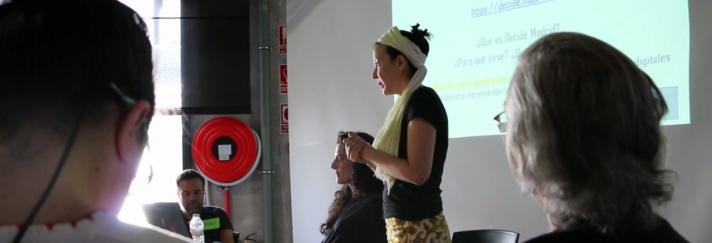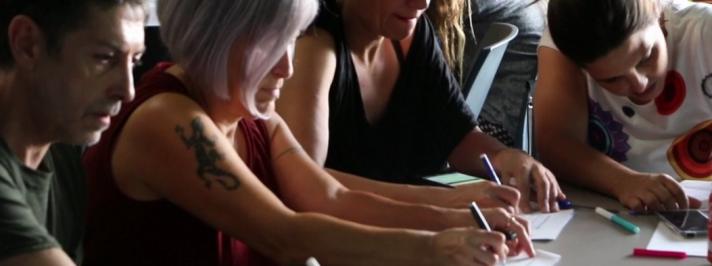On the 1st of July I witnessed a conversation that re-enacted and summarized very well many contemporary online and offline debates and rants on participatory democracy and citizen engagement. It happened in the context of a very well organised workshop designed and run by Saya Sauliere with Rebeca Díez Escudero, hosted by the EU Policy Lab at MediaLab Prado in Madrid. The workshop was one of the three activities (report here) that Saya and Rebeca designed to gather citizens’ input to contribute to the definition of a European eCitizen Charter. The exercise was also run in Portugal, France, the Netherlands, Poland and Estonia, in the framework of Lab Connections, with the key support of several local policy labs.
Saya Saulière – collaborator ParticipaLAB Medialab Prado (click for a video on the methodology)
The session went initially quite smoothly and offered insights consistent with those gathered in all other participating EU locations. We were focusing on the user experience of the more “traditional” digital services provided by public administrations, such as issuing official certificates and ID’s or accepting payments for taxes and fees. No one questioned that a well-designed service process and the availability and integration of several quality contact points, both online and offline, would fix most of the issues. If we think that the more advanced administrations already have or are opening positions for well-trained design officers, then we can definitely say that the situation will improve dramatically in the next few years.
Participants analyse and give feedback on public digital services
Things started to get interesting when we approached the second part of the workshop, which wanted to capture insights on Decide Madrid, the platform deployed by the municipality to allow participatory budgeting and citizen-led initiatives.
To begin with, most of the 20 participants had heard some form of news about the platform but never visited it, or opened an account to participate. Yet, everyone had a pre-conceived opinion which was not challenged but actually reinforced after a quick exploration of the platform. The very well-crafted composition of the group and the short time allowed for navigating, which simulated the typical attention timespan for online portals, allowed such opinions to immediately surface. They probably sound familiar, since we experience them every day on social media.
From the “I pay politicians to represent me, I expect them to take decisions, so don’t constantly bother me with questions” kind of stance, to the exact opposite, “I don’t want anyone to decide for me”, or the “this is a candy to distract us from the real problems” versus the “this is an opportunity for us to decide what matter to us”, the room immediately grow polarised and only the good atmosphere built previously, Saya’s skills as moderator and lack of time prevented the discussion to turn bitter.
Even though some feedback actually focused on navigational issues, what emerged strongly was a lack of interest in the functionalities and an absolute passion on the key issues of participatory democracy: legitimacy of proposals and choice, minimum levels of participation, personal vs. public responsibility, the interface with representative democracy, the clash with the elected power, trust in the platform’s owner and algorithms, etc. It did not matter if the platform already proposed a non-biased model that addressed such issues; there was too much interest in state one’s own position and preferences, and too little room to exit one’s comfort zone.
I have experienced this kind of situation way too many times in conversations and in online “debates”, and it was striking and revealing to view it unfold again in real-time. On the plane back to Brussels, and after exchanging impressions with colleagues and fellow designers, I started wondering if this lack of a safe space for meaningful conversations on engagement and participation could represent a key challenge for design and for policy labs.
The current practice at European, state and local level shows that the methodologies and tools available to consult stakeholders, especially those who are now under-represented, are still not fit for purpose. If we try to move from consultation to participation and engagement, the field for improvement and experimentation becomes even wider.
From the experience gathered in a few years I could probably say, without raising too many eyebrows, that most collaborative spaces, processes and tools still address and are designed for problems of practical and tangible nature (i.e. business and service processes, system functionalities, etc). When the conversation shifts to values and principles (i.e. who should decide on what, and for what purpose), the temptation is to either fall back into personal biases, pre-existing hierarchical schemes – with a preference for the “top down, therefore practical” – or to enter an indecisive and often frustrating “assembly mode”.
This translates in an open need for a space for meaningful and constructive conversations that lead to consensus on high level strategies and/or purposeful communities of practice.
We have a relatively limited practical experience with these kinds of challenges, and at the same time a highly heterogeneous and specialised range of places, methodologies and tools that could be potentially fitted for such task.
Third spaces, policy labs, fab labs, city labs, creative hubs, co-working spaces, online spaces for collaborative decision making, methods for participatory design and leadership, they all address a very important part of the whole and may hold collectively the key to build a flexible and adaptable system for engagement and participation. But we still need some form of meta-approach that can bring all the efforts together to focus on the discovery of shared values and principles and on embedding coherence and responsibility into actions and projects.
Can design accept the challenge? Can designers re-think existing methodologies and tools to explore practically the different forms of collective decision-making? Can we invent new forms of participation that move beyond the single vote to inform policy-making with relevant insights? Can we design rituals that reduce polarization to promote a shared understanding of our shared needs?
The question is open.



